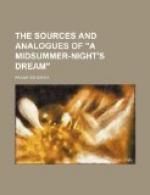[59] A similar episode survives in a Breton folk-tale, cited by Professor Kittredge in Child’s Ballads, iii. 504. In Huon of Bordeaux (E.E.T.S. edition, p. 265), Charlemagne mistakes Oberon for God.
[60] See Gummere, The Popular Ballad (1907), pp. 66-7.
[61] Cottonian, Caligula A. II. A later version is at the Bodleian, MS. Rawlinson C. 86, and a Scottish version in Cambridge University Library, MS. Kk. 5. 30.
[62] It was licensed to John Kynge the printer between 19 July 1557 and 9 July 1558. See Arber, Stationers’ Registers, i. 79. Two fragments are in the Bodleian; see Hales and Furnivall, Bishop Percy’s Folio Manuscript (1867), i. 521-535.
[63] In this year it is mentioned, as having been amongst Captain Cox’s books, in Laneham’s famous Letter. See Shakespeare Library reprint, p. xxx.
[64] Brit. Mus. MS. Addl. 27,879; see Hales and Furnivall, Bishop Percy’s Folio Manuscript, i. 142.
[65] Harl. 3810 (British Museum), printed by Ritson in Ancient English Metrical Romances (1802) ii. 248; the Auchinleck MS. (W. 4. 1, in the Advocates’ Library, Edinburgh), printed by D. Laing in Ancient Popular Poetry of Scotland, iii; and Ashmolean 61 (Bodleian Library, Oxford), printed by Halliwell in his Fairy Mythology, p. 36. The three are collated by O. Zielke, Sir Orfeo (Breslau 1880), a fully annotated edition. The last is used here.
[66] A grafted fruit tree; here probably an apple.
[67] It may be seen in Child’s Ballads, i. 215, with a full analysis of the romance, and in the present editor’s Popular Ballads of the Olden Time, Second Series, p. 208.
[68] Ballads, i. 338-340; see also various “Additions and Corrections” in the later volumes, and s.v. Elf, Elves, etc. in the Index of Matters and Literature.
[69] Morte Darthur (ed. Sommer), vi. l. 3.
[70] See below, p. 131.
[71] See J.M. Synge, The Aran Islands (1907), p. 48, and A. Nutt, Fairy Mythology of Shakespeare, p. 22.
[72] See Synge, op. cit., p. 47.
[73] See his admirable article on Sir Orfeo in the American Journal of Philology, vii. 176-202. The Courtship of Etain may be seen in English, translated from the two versions in Egerton MS. 1782. and the “Leabhar na h-Uidhri”—an eleventh century Irish MS.—in Heroic Romances of Ireland, by A. H, Leahy, i. 7-32.
[74] A. Nutt, Fairy Mythology of Shakespeare, p. 12.
[75] Wyf of Bathe’s Tale, 1-6.
[76] See A. Nutt, op. cit., pp. 16-17; and various authorities given by G.L. Kittredge, op. cit., p. 196 notes.
[77] Pronounced shee.
[78] Mr. Alfred Nutt (op. cit., pp. 19-23) is at pains to show the close association of the Tuatha De Danann with ritual of an agricultural-sacrificial kind, in the aspect they have assumed—“fairies”—to the modern Irish peasant. The Sidhe have fallen from the high estate of the romantic and courtly wooers and warriors, as they must once have fallen from the Celtic pantheon.




